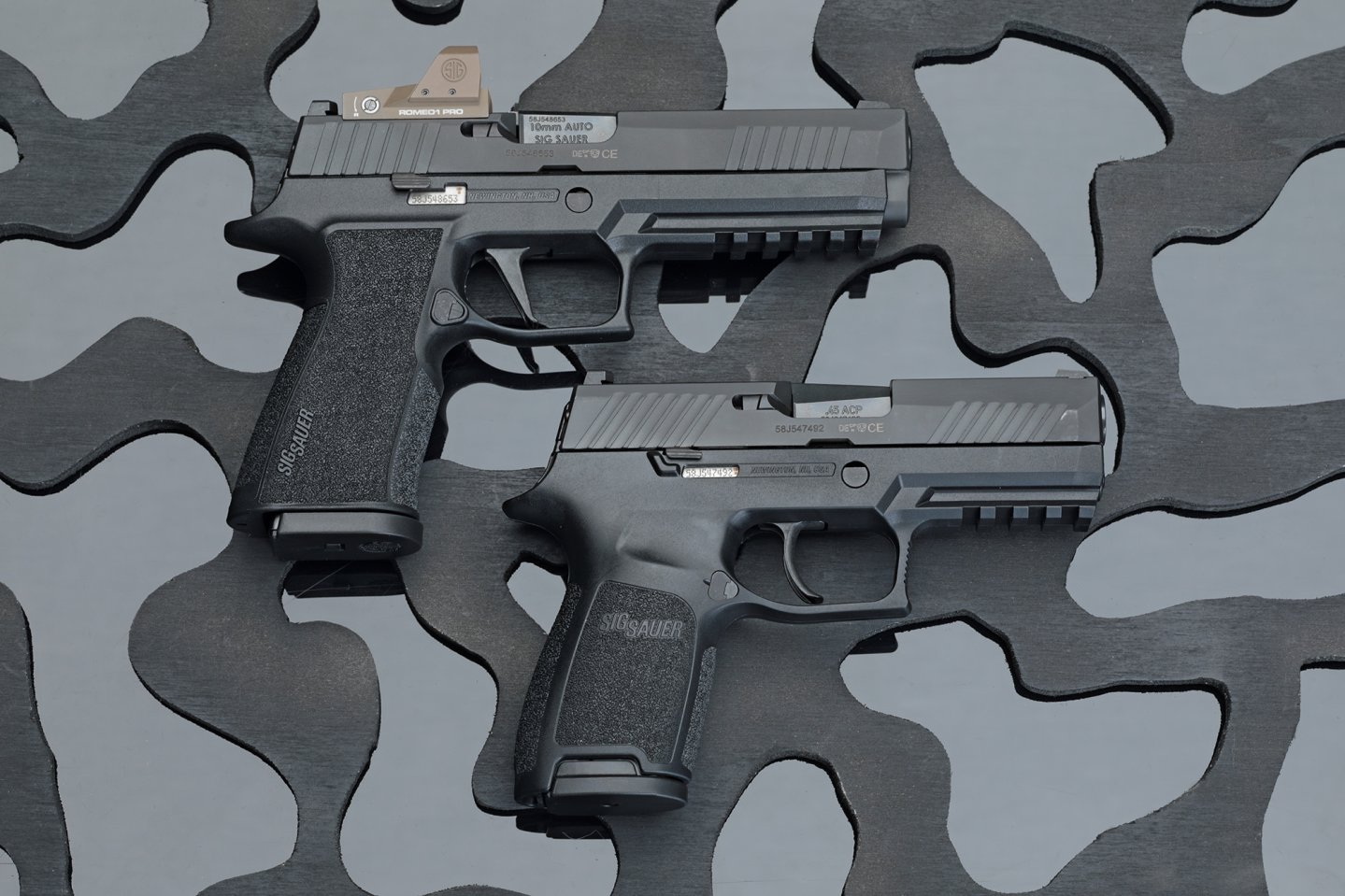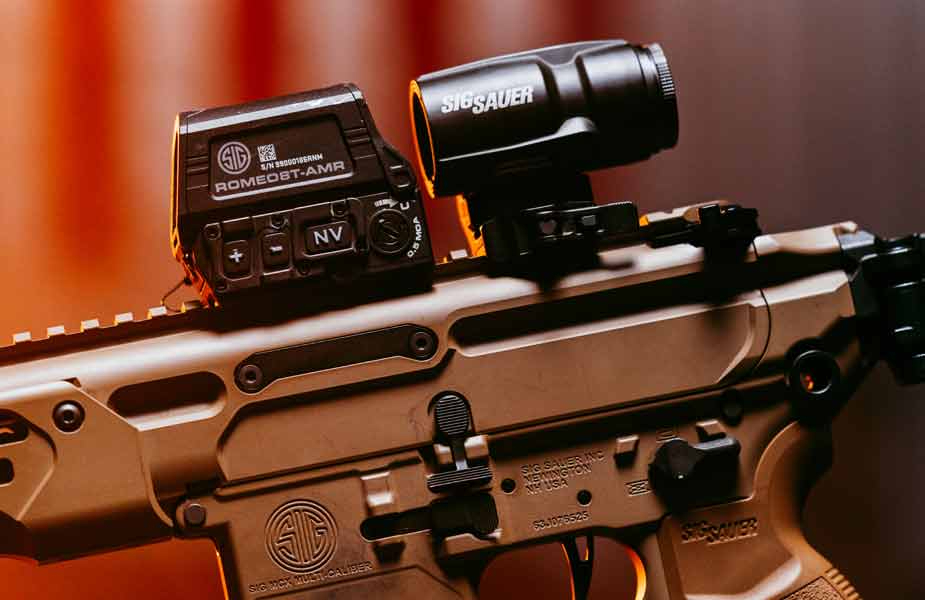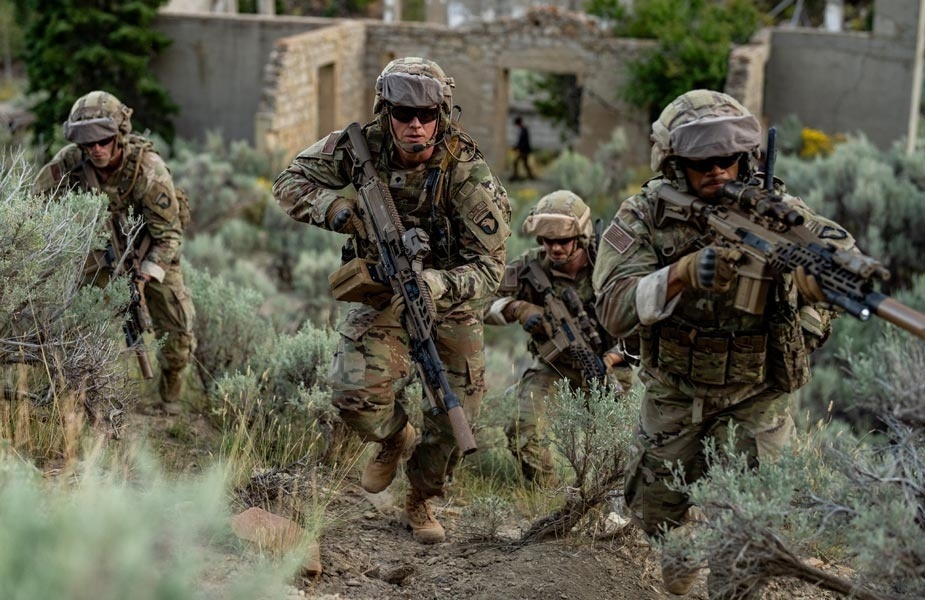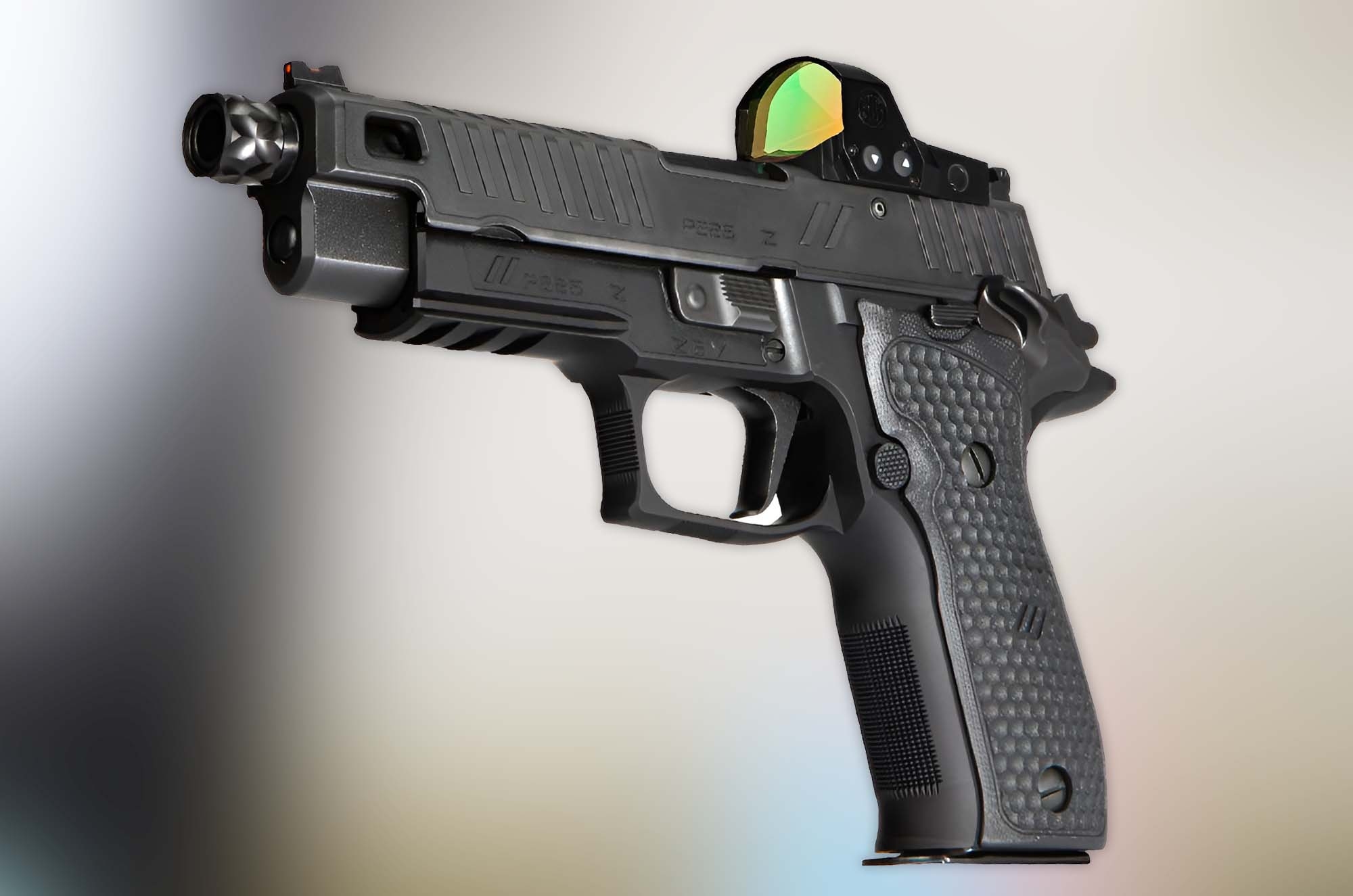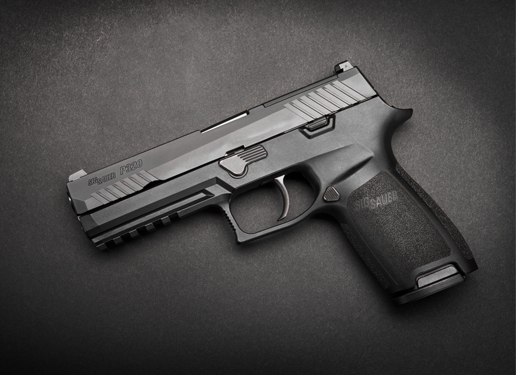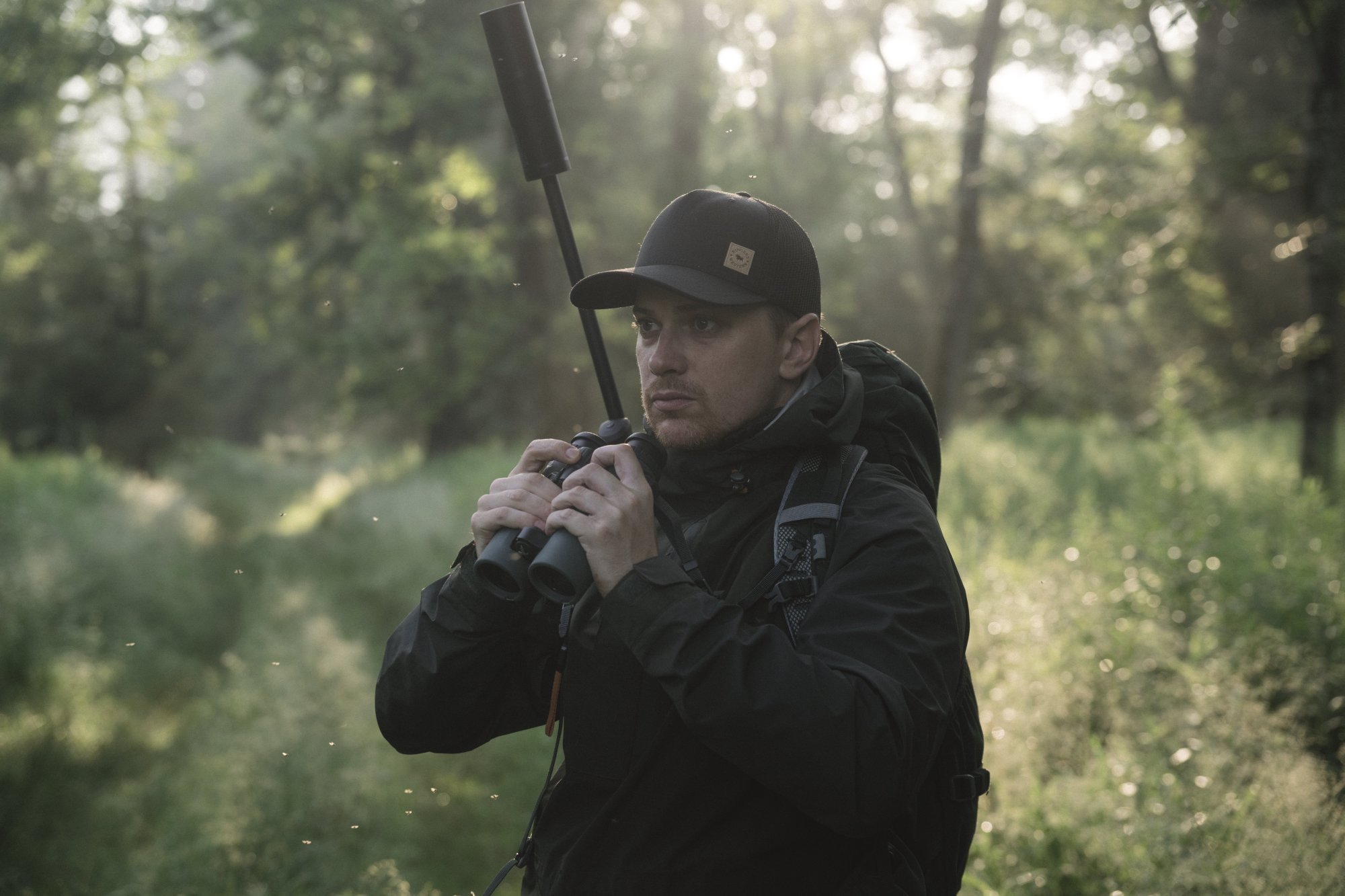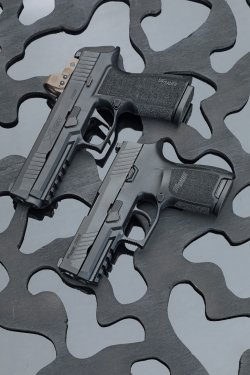
It is considered the chameleon of modern pistol design: the SIG Sauer P320. Hardly any other polymer-framed pistol has as many faces as the service pistol that appeared on the market around ten years ago. Equipped with an additional manual safety, it has been the service pistol of the US armed forces since 2017 as the M17/M18. The special feature of the P320 is that the fire control unit can be inserted into various frame grips. The frames are available in different dimensions and a variety of materials such as polymer, tungsten-infused and heavy polymer as well as aluminum and, more recently, steel. With the Tungsten Infused Grip Module (TXG), SIG Sauer has made a name for itself as a technology leader, as it is the first mass-produced frame grip that increases the weight by incorporating tungsten into the polymer base material and is nevertheless easy to injection mould in terms of production technology. With the AXG models, the company also offers aluminum grips, which in our opinion represent an interesting compromise between a successful feel and wearable weight.

Brand new and already on our wish list is the P320 XFive SXG, which is based on a full steel frame and will make the hearts of sports shooters beat faster. For example, the modular pistol in a sporty configuration with a heavy tungsten TXG grip frame could be used on the shooting range during the day and carried in the evening with a shorter, lightweight polymer grip frame. The SIG Sauer P320 is available in 9mm Luger, 10mm Auto and .45 ACP with barrel lengths from 3.7"/94 mm to 5"/127 mm. The Custom Works and Legion ranges also include special P320 models such as the P320 AXG Legion, P320 MAX (named after top IPSC/action shooter Max Michel), P320 XFive DH3 or P320 Spectre Comp Blackout with compensator. In addition, you can also put together your own customised P320 as part of the Custom Works project. However, not all grip and slide sizes can be combined with each other. The SIG P320 configurator provides information on what harmonises with what. Unfortunately, only a small part of the product lineup reaches Europe.
The comeback of the 10mm Auto and why Jeff Cooper might be enthusiastic about the SIG Sauer P320 XTEN
Around two years ago, SIG Sauer launched the P320 XTEN in order to provide a platform for the hype surrounding the 10mm Auto cartridge, which was just beginning to revive in the USA. Just a few years ago, the resulting .40 Smith & Wesson was considered the ideal compromise between target ballistic effect, controllability and magazine capacity. Today, the "40 Short & Weak" has completely disappeared from the catalog of many handgun manufacturers. Instead, the powerful 10mm Auto is making a comeback. Today, there is more factory ammunition available in 10mm Auto than a few years ago, so that some people might be tempted by the cartridge favoured by Combat Pope Jeff Cooper. The full-size P320 XTEN with a barrel length of 5"/127 mm and a magazine capacity of 15 rounds is certainly an interesting candidate.
In the USA, there is also a version with a 3.8"/97 mm barrel and a compensator integrated in the slide. Our full-size version lives up to its name with a length of 216 mm and a weight of around 950 grams. In view of the robust cartridge, a version with a heavy TXG Tungsten grip would certainly be desirable. Unfortunately, this grip frame is not available for the long 10mm/.45 ACP. The XTEN comes with a red dot sight cut and uses the footprint of the Leupold DeltaPoint, which is also used by the SIG Sauer red dots. Hunting with a handgun is unthinkable in our part of the world, but is practised to some extent in the USA. The XTEN in 10mm Auto with its long barrel and ballistic yield would be perfectly suitable for this purpose. German Sport Guns supplied its own Romeo 1 Pro red dot sight for the test. The shape of the X Series grip is kept flat and with a surface texture that extends far upwards offering a good compromise between grip and clothing protection when carried concealed. With a width of around 34 mm, even shooters with medium-sized hands should be able to cope well with the grip. In our opinion, the trigger pull weight of around 1,800 grams with light creep is fine. The sheet steel magazine holds 15 cartridges, whereby the last round needs a lot of pressure with the thumb to be packed into the magazine. However, the magazine also engages with difficulty when the slide is closed. Most users will get by with 14+1 cartridges.
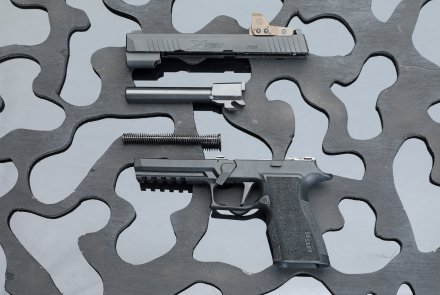
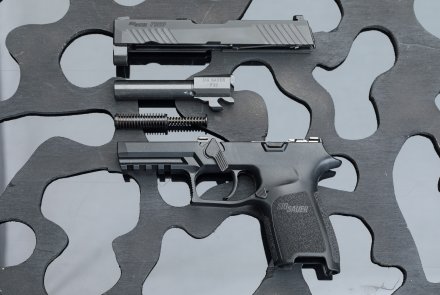
Handy and compact: SIG Sauer P320 Compact in .45 ACP
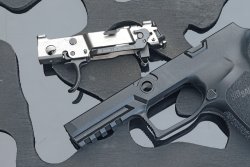
The SIG P320 Compact is the answer for anyone looking for a handy .45 with compact dimensions. With an overall length of around 215 mm and a weight of 808 grams, it still has room for 9+1 cartridges. The standard grip with a hint of thumb rest is somewhat rounder and, above all, shorter as a compact version. If you have a size 12 glove like the author, you will need to spread your little finger when changing the magazine, otherwise it will pinch. Unfortunately, SIG Sauer has no other interchangeable grip in its catalog for this model with the larger magazine well for the long cartridges. Our test gun does not have a slide cut for a red dot sight. In future, the compact version in .45 ACP will only be available with such an interface. Incidentally, it is the only P320 model that is set up for the original American .45 ACP. The full-size version with a barrel length of around 120 mm and 10+1 rounds has already been removed from the catalog. However, this also shows that this cartridge is no longer so popular even in its home country. With a measured trigger pull weight of around 2,200 grams, the trigger of the fully precocked striker-fired action is typical of a service pistol. As with the XTEN, the mechanical sights feature white contrast dots. Typical P320 features include the ambidextrous slide stop and the magazine release button that can be moved to the other side. Incidentally, the P320 Compact can also be converted to 10mm Auto or 9mm Luger with a conversion kit.
The 10mm Auto and .45 ACP from the perspective of the shooter and the reloader
As the international market is currently offering more 10mm Auto pistols and ammunition than it has for a long time, we would like to briefly outline the advantages and disadvantages compared to the .45 ACP. The 10 mm Auto has the biggest advantage over the .45 ACP in terms of performance and magazine capacity. It can easily be pushed to 800 joules, whereas the .45 ACP reaches the end of the line at around 550 to 600 joules due to the lower gas pressure. With bullet weights of 135 to 200 grains, reloaders can easily adapt the 10mm Auto to their personal requirements. As a rule, the magazine will hold one or two more cartridges, but this is not relevant for hunting use. The disadvantage of the 10mm Auto is that you don't know how long the second spring will last and what the supply of factory ammunition will be like in the future. If you don't reload, you can quickly be affected by shortages. There is no need to worry about this with the .45 ACP. Although the former US Army cartridge is no longer so popular for new guns, the stock of old firearms is so high that the industry produces enough ammo in this caliber. In addition, the .45 ACP has the advantage that it always travels in the subsonic range and offers sufficient cross-section even with a non-expanding or insufficiently expanding bullet.
With the SIG Sauer P320 XTEN and the P320 Compact on the shooting range
The P320 XTEN was brought to rest on the sandbag for the accuracy test at a distance of 25 meters. Seven loads from 170 to 200 grains were used. The mounted Romeo 1 Pro red dot sight with an extremely clean, sharply defined 6-MOA dot (44 mm at 25 meters) proved to be ideal for checking shooting performance. The soft PPU 170-grain JHP won the race at 52 mm (a thoroughly satisfactory result for a high-performance polymer-frame utility pistol), followed by our handload with the 200-grain Hornady XTP and the PMC 170-grain JHP factory cartridge. Firing the cartridges showed the range of performance of the 10mm Auto, which was released in 1983. While the PPU 170 JHP was at .40 S&W level, the Hornady 180-grain XTP delivered a powerful 800 joules of energy. Due to the comparatively high barrel axis of the P320 series, there is also a corresponding rotational movement. There were no malfunctions to report and the mini red dot sight also survived the pithy 10mm auto ammunition seemingly without any damage. With the .45 ACP Compact, we moved on to the 15-meter range. Here too, with seven loads, two 5-shot groups were to serve as the basis for evaluation.
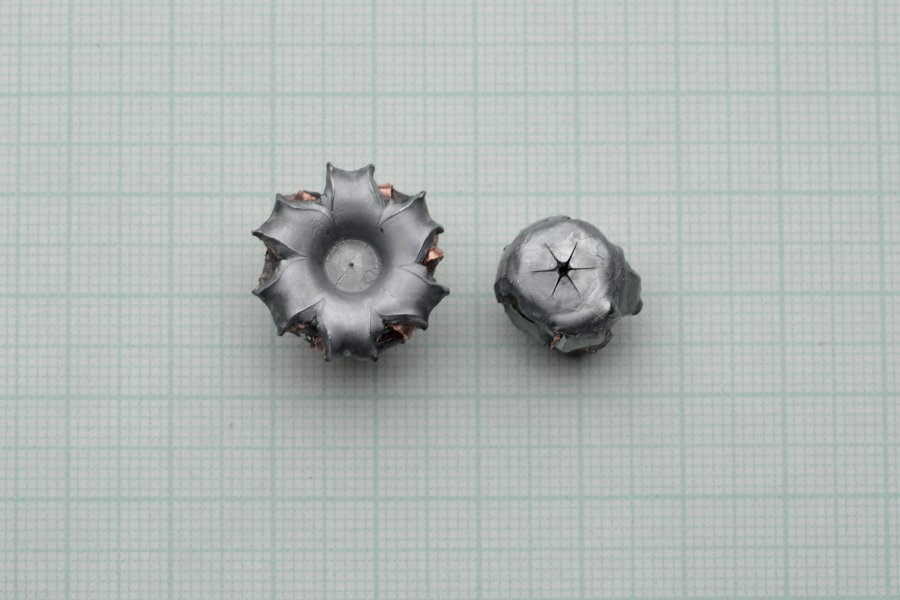
The most accurate load proved to be the medium-defensive load in the form of the 185-grain Speer Gold Dot with 37 mm. In second place was the powerful 220-grain Hornady Critical Duty and in third place a copy of a typical hardball load with a 230-grain Speer TMJ bullet. Even the .45 Compact did not allow itself a single malfunction. The harder loads kick quite well in both .45 and 10mm Auto, and you should be aware of this when buying a polymer gun in such strong-recoiling calibers. However, you should bear in mind that you should also train with your tools of the trade. With such cartridges, this can turn into a lot of work.
Conclusion: SIG Sauer P320 XTEN (10mm Auto) and Compact (.45 ACP)
If you are looking for a versatile SIG Sauer P320 with more power than the 9mm, you might find what you are looking for in these two protagonists. Which caliber to choose depends somewhat on personal preference. Although the 10mm Auto has more power to offer, it could quickly disappear from the ammunition shelves in the next few years. You don't need to worry about that with the .45 ACP.
More information on the SIG Sauer P320 is available on the manufacturer's website.


